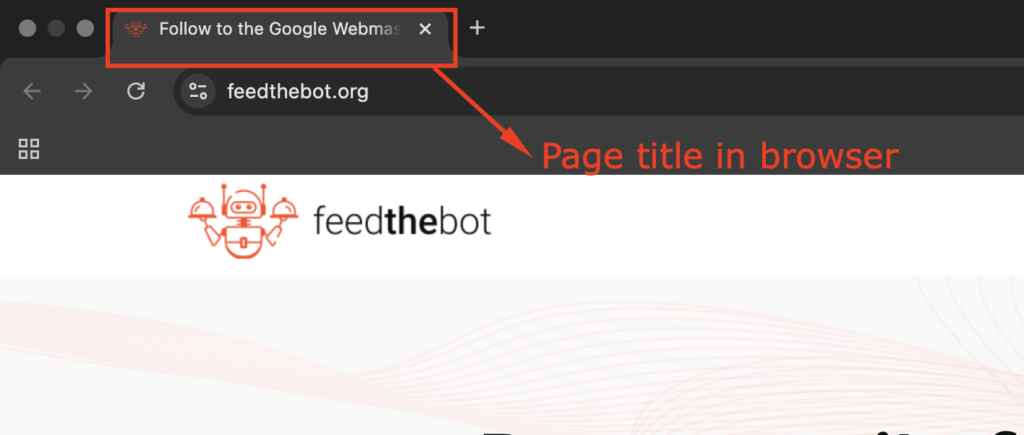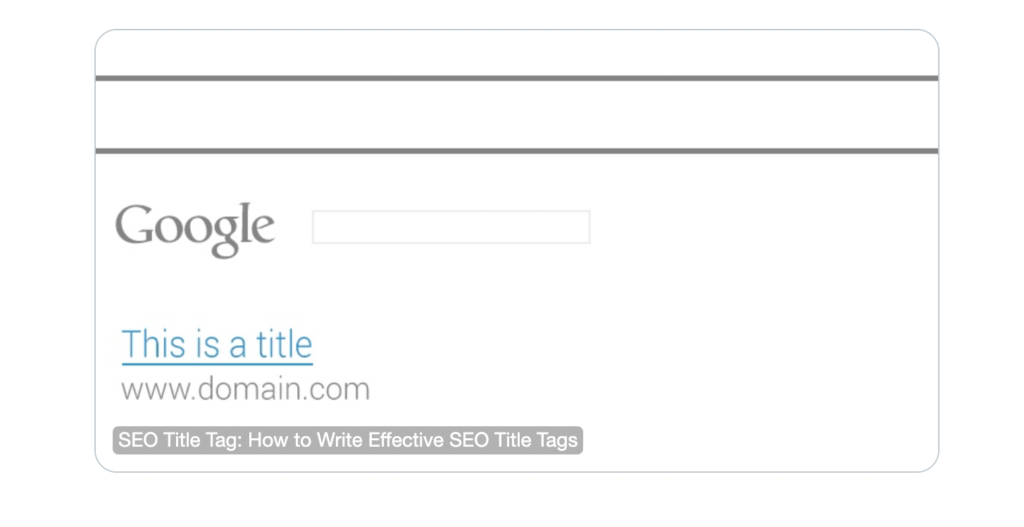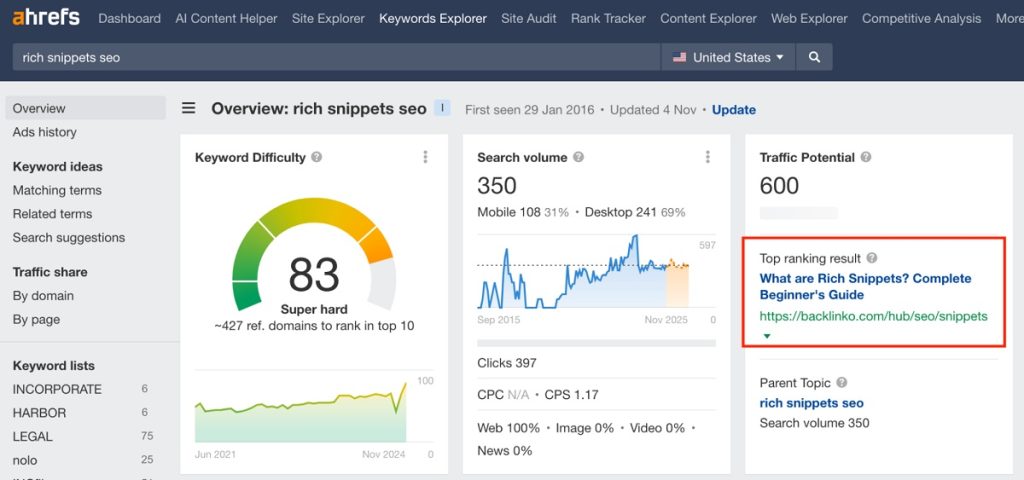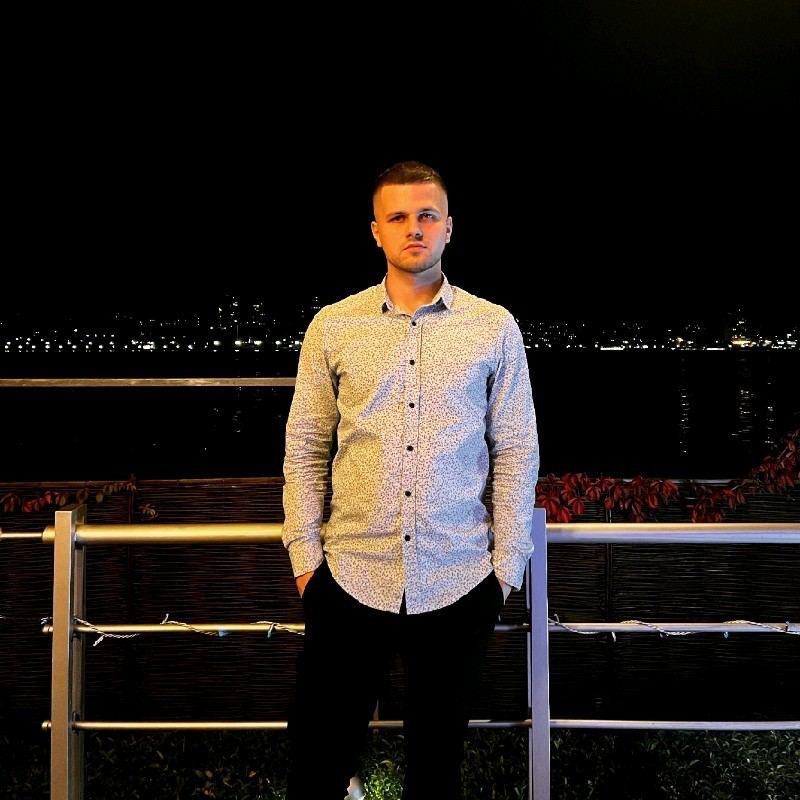Latest update: April 23, 2025
Title tags aren’t just text; they’re like the digital storefront of your website. Think of your site as a physical store, and the title tag as the sign above the door. It’s the first thing people notice, and it often decides whether they’ll click through to explore more.
What is a SEO Title Tag?
Think of the title tag as the headline for your webpage—it’s what people see in search engine results pages (SERPs) and browser tabs. It helps search engines understand what your page is about and can encourage users to click on your site.

It’s like a billboard for your webpage. A good title tag grabs people’s attention and makes them want to learn more about what you offer. It’s also crucial for SEO because search engines use title tags to determine how relevant your page is to a user’s search query.
In technical terms, a title tag is an HTML element found in the head section of your page’s HTML code. It specifies the title of your webpage and appears as the clickable headline in SERPs. It’s important for usability, SEO, and social sharing. The title tag should be an accurate and concise description of your page’s content. It’s a critical part of website optimization that affects both the user experience and your site’s search engine ranking.
How Does The Title Tag Appear?
The HTML code for a title tag appears as follows:
<head><title>Example Title</title></head>When working with the raw code of a webpage, the title tag is usually located within the <head> section of the page’s HTML structure.

Page title tag in browser tab:

The title tag in SERPs:

Title tags are also visible on social media posts. They appear below the featured image.

If you’re using a CMS like Shopify or WordPress, updating title tags is easy—you don’t need to edit the HTML code. You can use plugin like Yoast in WordPress and FavSEO for Shopify.
How Important Are Title Tags for SEO?
Title tags play a crucial role in both user experience and SEO. They should be compelling for visitors while also helping search engines understand your content.
As a key on-page SEO element, title tags influence how Google ranks your page for relevant searches. When optimized correctly, they can improve visibility and drive more organic traffic.
For users, title tags are often the first thing they see in search results. A clear, engaging title can increase click-through rates and bring more visitors to your site. The key is finding the right balance between SEO-friendly structure and user appeal.
Best Practices for Writing SEO Optimized Title Tags

Creating effective title tags is essential for improving your website’s search rankings and attracting more clicks. A well-optimized title helps search engines understand your content while making it appealing to users.
1.Keep Titles Clear and Concise
Your title tag should accurately describe the page’s content while staying within 50-60 characters. This ensures it displays properly in search results and remains easy to read on all devices.
2.Use Relevant Keywords Strategically
Place your primary keyword at the beginning of the title to highlight relevance. Avoid keyword stuffing —forcing too many keywords can make your title unreadable and may lead to search engine penalties.
3.Incorporate Your Brand for Trust and Recognition
If your brand name is well-known or a key search term, include it at the end of the title tag. This strengthens brand recognition and builds credibility while keeping the main focus on the content.
4.Ensure Every Page Has a Unique Title
Duplicate titles confuse search engines and users, making it harder for your pages to rank. Each title tag should be distinct and accurately reflect the specific content of the page.
5.Avoid Generic Titles That Lack Context
Titles like “Home” or “Profile” don’t provide enough information and won’t perform well in search results. Instead, use descriptive, keyword-rich titles that clearly convey your content’s purpose.
How to Optimize a Title for SEO?

Optimizing a title tag for SEO involves balancing keyword inclusion with readability and relevance. Follow these steps for effective optimization:
1.Keyword Research for SEO Title
Identify a relevant keyword for your target audience. Use tools like Google Keywords Planner, Ahrefs, Semrush or AI Chat Bots for keyword research to find a balance between how difficult it is to rank for, how often it’s searched, and how well it matches your content.
2.Start with the Primary Keyword
Place your main keyword at the beginning of your title to highlight its importance. Ensure the title accurately represents the page content. Misleading titles can increase bounce rates, negatively affect your site’s ranking, and be perceived by Google as SEO manipulation.
3.The Length of the Title Matters for SEO
Aim for a title length of 50-60 characters. This length ensures your title displays fully in search engine results, improving readability and user engagement. Keeping titles concise also makes them more memorable and allows you to include targeted keywords effectively without sacrificing clarity or appeal.
4.Use Power Words and Numbers
Incorporate power words like “Ultimate,” “Easy,” or “Quick,” along with numbers to make your titles more compelling and clickable. Power words add emotional appeal, while numbers create a sense of structure or list-based content, both of which can lead to higher click-through rates by capturing users’ attention and setting clear expectations.
5.Competitors Analysis
Analyze competitors’ title tags to understand what strategies are working in your niche. Compare their titles with yours to identify gaps or opportunities for improvement. Look for patterns in keyword usage, tone, and structure, and consider implementing effective elements from top competitors to enhance your own titles and improve your search visibility.
6.SEO Title Generators
Use SEO title generators like Ahrefs Title Generator, Semrush Title Generator, and similar tools to brainstorm title tag ideas for your target keywords. These tools can help you generate optimized, attention-grabbing titles quickly, saving time and ensuring that your titles are both relevant and competitive. Exploring various title suggestions can also inspire creative angles and improve your content’s appeal in search results.
What is a Bad Strategy When Creating Quality Title Tags?
A common mistake when writing title tags is overstuffing them with keywords. This means cramming too many keywords into a small space, making the text awkward and hard to read. While it may seem like a way to boost search rankings, it often backfires. Search engines value relevance and readability, and titles overloaded with keywords can come across as spammy, hurting your credibility.
Instead, focus on creating a clear, engaging, and informative title that accurately describes your page’s content. Use your main keyword thoughtfully, but avoid overdoing it. A well-written title can help you attract more organic traffic and improve your SEO.
Difference Between SEO Titles and Descriptions
SEO titles and descriptions are both important for making your website more visible in search engine results, but they have different roles.
SEO titles are the clickable headlines you see in search results. They need to be concise, informative, and include your target keyword to attract clicks and drive traffic to your site.
SEO descriptions, on the other hand, are the brief summaries displayed under the title. They give more details about your page’s content and can influence whether users decide to click. While they don’t directly affect search rankings, a well-written description can significantly boost your click-through rate.
Simply put, SEO titles grab attention, and descriptions provide the context users need. Both work together to help increase organic traffic to your site.
Conclusion
Understanding how to use title tags and meta descriptions effectively is crucial for getting your site noticed in search results. Title tags are important for rankings and need to be precise, using the right keywords and keeping things brief to grab attention quickly. On the other hand, meta descriptions don’t directly impact rankings but are key for boosting click-through rates by providing an engaging summary of your content. Together, these elements are essential for attracting users and guiding them from a search result to your site’s content.
FAQ
The title tag and H1 both describe a page’s content but serve different purposes. The title tag appears in search results and browser tabs, focusing on SEO and clicks, while the H1 is the main on-page heading, designed for readability. Keeping them aligned yet distinct improves both SEO and user experience.
Examples:
Product: Buy Handcrafted Leather Boots | Free Shipping | BrandName
Blog: 10 Proven Strategies to Boost Your Immune System
Service: Top-Rated SEO & Digital Marketing | CityName
These titles use keywords, convey value, and are well-structured for SEO.
Yes, title tags are considered a significant ranking factor by Google, though the algorithm’s complexity means they are just one of many elements evaluated. Title tags help search engines understand the topic and relevance of a page, influencing how it’s indexed. A well-optimized title tag that accurately reflects the page’s content and incorporates targeted keywords can positively impact a page’s ranking in search results.
Choose separators for SEO based on readability and space. Pipes (|) and dashes (-) are popular for clean, scannable titles.


